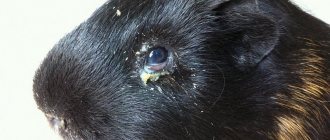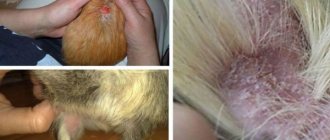Rodents are very popular among pets. They don’t take up much space, sit in their own cage and don’t bother anyone. Among them I would like to highlight the guinea pig, which is quickly and easily tamed and brings joy to its owners. With proper care, life expectancy in captivity reaches 10 years. The indicator directly depends on the person, nutrition, lifestyle, conditions of keeping and caring for the pet. In this case, the animal can live practically without disease, or get sick even under good living conditions.
Some diseases are transmitted genetically. These include a tumor in a guinea pig. It mainly manifests itself in individuals over the age of five years. Besides genetics, the reasons can vary greatly. An abscess occurs even from bruises, injections with sawdust, branches and other objects. In general, tumors in a guinea pig can occur on the back, neck, side, cheek, stomach, and even inside the body. Without treatment, the animal is doomed to death.
Neoplasms can be benign or malignant. In the second case, cancer is often diagnosed.
The cause of the abscess and its symptoms
An abscess is an inflammatory lesion in which pus accumulates. It is formed due to the penetration of infection and the proliferation of pathogenic microorganisms. This is a dangerous disease, and as it develops and spreads, death cannot be ruled out.
In some cases, the animal’s body copes with the inflammatory process itself, the pus comes out, and the wound heals. But if the focus is deep, infection provocateurs multiply quickly, the abscess progresses rapidly, and urgent treatment is necessary.
The causes of infection may be damage to the skin by hay or a bite from another animal. If the wound is not treated, microbes and bacteria penetrate into it, causing inflammatory processes. Externally, the disease manifests itself by the formation of a lump. Its location is determined by the cause of the inflammatory focus:
- When two animals are kept in the same cage, fights can occur between the pets. As a result of bites, infectious abscesses appear on the back and back.
- In the process of eating hay, microtraumas can occur. They cause tumors in the head area.
- In the case of molars growing into the bone, a periapical formation occurs in the jaw area.
If the formation is small, you can try to treat the abscess at home. It is necessary to initiate the process of the pus coming out, for which an iodine mesh is made on the tumor, compresses with Vishnevsky ointment are applied. In most cases, surgery is required to treat abscesses. In addition, the tumor can appear in other diseases. Therefore, it is better to contact a veterinary hospital.
There are several stages in the development of the disease:
- the appearance of swelling in the affected area;
- tumor growth, pain during mechanical action;
- the appearance of an opening for the release of pus.
Diseases dangerous to people
Guinea pigs can be a source or carrier of diseases that are dangerous to humans. You can become infected with skin or intestinal parasites from an animal. Roundworms cause strongyloidiasis, and giardia causes giardiasis. Liver fluke can cause severe liver disease, which in most cases is fatal. From a guinea pig, a breeder can acquire diseases caused by bacteria and viruses: salmonellosis, tuberculosis and leptospirosis. The most commonly transmitted skin disease is lichen. Regular flu can be transmitted both from the breeder to the animal, and from the animal to the breeder. Avoiding infection is not difficult: you need to keep the cages clean, wash your hands after each cage cleaning, as well as after interacting with the animal, and avoid getting saliva or animal hair in your mouth. Any illness in an animal - use a disposable medical mask.
Treatment of abscesses
The main technique for an abscess is resection of diseased tissue and disinfection. It is performed under general anesthesia. After it, for complete recovery and to exclude relapse, the following are prescribed:
- treatment of surgical sutures within 2 weeks;
- antibiotic injections for a week;
- washing the abscess capsule if it remains after surgery.
Periapical abscesses are particularly difficult, as they prevent the pet from eating. After their removal, the following are added to the main treatment regimen:
- anesthetics;
- forced feeding;
- course of corticosteroids.
If there are complications, infusion therapy is prescribed.
Contact your veterinarian
The growth of tumors cannot be stopped without the help of a veterinarian. The doctor performs a physical examination that helps determine the presence and type of cancer. Timely contact with a specialist increases the chance of a successful treatment outcome by up to 70%. Otherwise, a pig with a tumor will live no more than three years. Therefore, you should not waste time treating your pet with “folk” remedies like hemlock or vegetable oil.
After surgery, the animal is prescribed a course of medications aimed at restoring immunity and stopping the spread of infection.
Pigs are difficult to tolerate serious surgical interventions. Regular preventive examinations – 1-2 times a year – help prevent treatment that is difficult for your pet. The examination detects the disease at an early stage, when treatment requires less effort and cost.
The appearance of tumors is a serious pathology. Even benign lesions can lead to death if left untreated. Regular visits to the veterinarian for preventive examinations help prevent serious consequences. The owner must pay attention to the health and appearance of the pet in order to notice warning signs.
Various types of tumors, their localization
Guinea pigs over the age of five years are at risk for cancer. Malignant tumors in these animals are diagnosed quite often. The appearance of neoplasms is provoked by various reasons. This may be a hereditary predisposition, stress, obesity. The appearance of a tumor can be caused by food containing chemical dyes and preservatives. They can occur on mucous membranes, organ tissues, and bones.
A benign tumor, unlike a cancerous one, does not spread throughout the body. These tumors are dangerous because as they grow, they put pressure on neighboring organs and disrupt their functions. Large tumors can completely immobilize the animal. These formations are easily cured by surgical removal.
A malignant tumor not only grows, but also forms metastases that penetrate healthy tissue. If such a disease is diagnosed, euthanasia is recommended, since cancer cannot be completely cured. You don’t have to kill your pet, just let it live out its term. In this case, the guinea pig needs to be provided with quality care, good nutrition and painkillers.
Most neoplasms in pets appear in the following areas:
Types of tumors in guinea pigs
Guinea pigs may develop tumors:
- on the side;
- on the back;
- on the mammary glands;
- on the neck;
- on the skin;
- on the cheek;
- on the bones;
- in connective tissues.
Important! If your guinea pig has a lump, it is recommended not to delay a visit to the veterinarian - some types of diseases occur quickly, but can be treated in the early stages.
On the side and on the back
If you find a lump in the area of the rodent's ribs, this may be a sign of cancer of the lungs, intestines, liver, spleen, or kidneys. Thus, a malignant neoplasm in the lungs begins with a benign adenoma on the side or back. It can be diagnosed using x-rays. The disease can be recognized by the presence of heavy breathing. If the problem is detected in time, it can be solved with the help of surgery. Otherwise, the enlarged tumor will not allow it to be separated from the lung tissue.
Cancer of internal organs is accompanied by poor appetite, weakness, apathy, and the presence of traces of blood in the area of the loop or anus.
A lump in the lower back may indicate a blockage of the sebaceous gland, an organ that is responsible for the production of pheromones and the unique smell of the animal. Although its size varies from pig to pig, when healthy it is not swollen and does not require any action.
Did you know? Guinea pigs originated from animals that weighed 700 kg and were the size of an ox. (Which animals? not clear fact)
However, sometimes blockages occur due to the fact that dust, dirt, or hair gets into the hole, which can lead to the development of a tumor, atheroma (follicular cyst) or abscess. You cannot solve this problem on your own; surgical intervention is required. Another cause of a tumor on the back can be trauma from a sharp object, which results in purulent inflammation.
Mammary gland
The mammary glands of pigs are located on the stomach between the hind legs. Bumps on them occur in both females and males and may indicate a benign or malignant tumor. Your chances of getting sick increase with age. This type of cancer usually does not metastasize, so after surgery you can forget about it. Sometimes a fistula or abscess may form in this area.
On the neck
Lumps on the neck may indicate:
- inflammation of the lymph node;
- inflammation due to injury;
- lymphosarcoma;
- enlarged thyroid gland.
We recommend finding out how long a guinea pig lives at home.
Lymph nodes can become inflamed if the animal is sick - for example, with a sore throat. If a pet ate food with sharp tips (hay, spikelets), it could get pricked, and the damaged skin could become inflamed. Lymphosarcoma is a malignant neoplasm that is caused by a retrovirus and quickly spreads throughout the body. Other lymph nodes and internal organs become inflamed, and leukemia begins. The disease progresses quickly and almost always results in death of the mumps.
Thyroid problems are rarely diagnosed in pigs. The cause of this disease can be an unbalanced diet.
On the skin
Sometimes the lump can be a fatty deposit that occurs when your pig is overfed. If bumps are found on the skin of the hind legs, this may be a symptom of skin cancer (basal cell tumor). This problem can be solved by surgery at an early stage. In the initial stage, the swelling has an oval shape and does not progress for a long time, but then pus may begin to flow from the lump.
Important! At the moment purulent secretion is detected, the neoplasm becomes dangerous and can grow.
A lipoma or wen may form under the pig's skin. Usually they are not touched if they do not interfere with the animal and do not increase in size.
On the cheek
If there is swelling in the eye area, the animal may have a disease of the organs of vision. The cause may be dirty litter, which promotes the development of infectious microorganisms. Hard food can scratch the cheek and cause inflammation. In these cases, the veterinarian may decide to open the lump or prescribe treatment.
It will be useful for you to learn how to properly care for your guinea pig.
On the bone
One of the most aggressive types of cancer is osteosarcoma, a bone tumor in a pig's hind legs or ribs. It is difficult to diagnose and cannot be treated. The paw can be amputated, but there is no guarantee of the animal's recovery.
Connective tissue tumors
A benign tumor of connective tissue is called a lipoma, or wen. It is soft to the touch, grows slowly, does not cause pain in the animal, and is mobile. This type rarely develops into a malignant one, but degeneration into liposarcoma is possible. Veterinarians operate on such tumors only if they grow rapidly.
Did you know? The fetus of a pregnant female guinea pig may dissolve on its own or stop developing for several years.
Mammary gland
Older female and male guinea pigs have a serious risk of developing a tumor in the mammary glands. Most often these are benign tumors. When pathology appears in the lower abdomen, a lump appears that is not connected to the subcutaneous tissue and has a dense structure.
A malignant tumor differs from a benign one:
- swelling;
- formation of infectious foci, abscess;
- connection with subcutaneous tissue.
Diseases
On average, guinea pigs live 8 years. They have strong immunity, so they rarely get sick. In general, rodent diseases are divided into the following categories:
- mechanical damage caused by a fall, blow, bite of another animal;
- infections transmitted by bacteria, viruses, parasites;
- diseases caused by poor diet or maintenance: digestive problems, obesity, etc.;
- genetic pathologies.
Tumors in guinea pigs are not uncommon. Unfortunately, their appearance is mainly due to genetic reasons beyond the control of the owner.
Back and sides
Swellings on the sides and back appear when a tumor forms on an internal organ. In most cases these are oncological diseases. A lump may appear on the side if the liver, kidney, spleen, intestines, or lung are affected by a malignant tumor.
In addition to the formation of a tumor, in the presence of malignant neoplasms, the animal experiences the following symptoms:
- loss of appetite;
- lethargy, apathy;
- discharge of blood from the mouth, its appearance in urine and feces.
Malignant and benign tumors
The main cause of tumors in pigs is genetic. If an animal develops cancerous tumors, they will most likely recur in its descendants. There is a theory that individuals suffering from obesity caused by poor diet are more susceptible to cancer. Externally, the tumor looks like a lump on the back, neck or other place. If such a formation is noticed on the pet’s body, the animal should be shown to a veterinarian.
Malignant tumors are characterized by rapid growth and the appearance of metastases (the spread of new tumors throughout the body). They grow in different places, often on the mammary glands or testes. Benign formations are surrounded by a septum that prevents them from growing. Thanks to this, they are successfully removed without relapse. Incurable tumors become grounds for euthanasia. Otherwise, your pig will need regular doses of pain medication and constant care.











